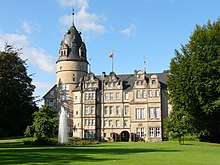House of Lippe
| House of Lippe | |
|---|---|
 | |
| Country | Lippe, Schaumburg-Lippe |
| Founded | 1123 |
| Founder | Bernhard I |
| Current head | Stephan, Prince of Lippe |
| Final ruler | Leopold IV |
| Titles | Lord, Count, Prince |
| Deposition | 1918 |
| Cadet branches | Lippe-Biesterfeld Lippe-Weissenfeld Schaumburg-Lippe |


The House of Lippe (German: Haus Lippe) is the former reigning house of a number of small German states, two of which existed until the German Revolution of 1918–19. Princess Beatrix of the Netherlands, former Queen of the Netherlands, is an agnatic member of this house.
History
The House of Lippe descends from Jobst Herman, Count of Lippe (died c. 1056), whose descendant Bernhard I was the founder of the state of Lippe in 1123. The family has produced several of the longest-reigning monarchs in Europe, including the longest reigning, Bernard VII, Lord of Lippe.
In 1613, the House's territory was split into the counties of Lippe-Detmold, Lippe-Brake and Lippe-Alverdissen. In 1643, Count Philipp of Lippe-Alverdissen founded the Schaumburg-Lippe line of the House of Lippe. After the other lines became extinct, their territories were inherited by either Lippe-Detmold (which in 1789 became the Principality of Lippe) or Schaumburg-Lippe (a principality since 1807).
In 1905, with the death of Prince Alexander, the senior Lippe-Detmold branch of the family became extinct and Count Leopold of Lippe-Biesterfeld (head of a non-ruling junior branch line) succeeded him as Prince.
During the German Revolution of 1918–19, the ruling Princes of Lippe and Schaumburg-Lippe were forced to abdicate, ending the family's 795-year rule. Stephan, Prince of Lippe (b. 1959) still owns the estate and castle at Detmold.
In 1928, Prince Leopold's three sons by his first wife signed up to the Nazi Party. The eldest, Prince Ernst, is reputedly the first German prince to do so.[1]
In 1937, Prince Bernhard of Lippe-Biesterfeld married Princess Juliana of the Netherlands. On the accession of their daughter Beatrix in 1980, the Netherlands Royal House officially remained known as the House of Orange-Nassau, although Beatrix and her sisters are agnatically members of the House of Lippe.
States ruled by the House of Lippe
- Lippe (1123–1918), known as Lippe-Detmold from 1613
- Lippe-Brake (1613–1709)
- Lippe-Alverdissen (1613–1640 and 1681–1777)
- Lippe-Biesterfeld
- Lippe-Weissenfeld
- Schaumburg-Lippe (1643–1918)
- The Netherlands (1980-2013) (although known as the House of Orange)
See also
References
External links
- Marek, Miroslav. "Genealogy of the House of Lippe". Genealogy.EU.
- Regnal chronology of Lippe
